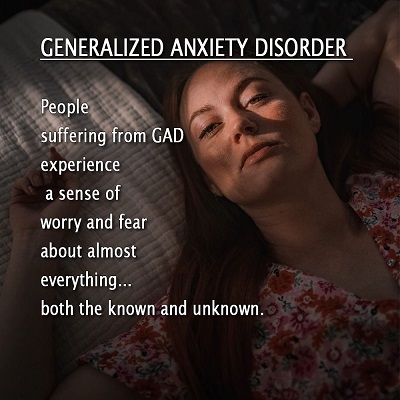 People suffering from Generalized Anxiety Disorder experience a sense of worry and fear about almost everything. They may anticipate tragic events happening, and find it difficult not to worry about their health, money, family, or anything in their life. These worries are usually just unnecessary worrying, and to most people, they are seen as being exaggerated or imagined.
People suffering from Generalized Anxiety Disorder experience a sense of worry and fear about almost everything. They may anticipate tragic events happening, and find it difficult not to worry about their health, money, family, or anything in their life. These worries are usually just unnecessary worrying, and to most people, they are seen as being exaggerated or imagined.
For GAD sufferers, their everyday existence is filled with fear, both of the known and the unknown. Ultimately, their apprehensions control their way of thinking. This later affects their daily functioning at work, disturbs their academic performance, restricts their social activities, and adversely influences their relationships.
Although these are all common sources of worry, if someone is in a state of endless fear or worry over them, then it may be possible that they are suffering from Generalized Anxiety Disorder.
While many people with this condition know that they are ‘over-anxious’ about many things, they feel that have no control over their apprehension and related anxiety.
Physical Symptoms
GAD, although a mental health disorder, can also produce physical symptoms such as the following:
- The unnecessary and continuing worry can lead to tense muscles, headaches, and sweating.
- An impractical perspective of life problems can result in irritability and restlessness.
- Difficulty focusing can lead to migraines, eye soreness, and nausea.
- Exhaustion, plus they may also have trouble falling asleep or staying asleep.
- Physical unsteadiness and easily alarmed.
Factors That May Cause GAD
The precise source of GAD is not completely identified, but some factors can contribute to its development, such as genetics, brain chemistry, and environmental stressors.
Based on many reports from the Anxiety Disorders Association of America, anxiety disorders can be transferred from one family member to another by certain family environmental dynamics like styles of parenting and continuous family conflict. An example is a hovering parent of many years; this can turn a child into a cowering adult.
Times of suffering and traumatic events, such as sexual abuse, the sudden death of a loved one, a divorce, or abrupt change in jobs or schools, can contribute to the development of GAD and can exacerbate the symptoms. Similarly, the use of and withdrawal from addictive substances, like alcohol, caffeine, and nicotine, can also intensify anxiety.
The specific nerve cell pathways that link the parts of the brain that engage thinking and emotion, rely on chemicals called neurotransmitters to convey information from one nerve cell to another. If these pathways that connect specific brain sections do not operate as they are supposed to, it can lead to problems associated with moods and anxiety.
Drugs, psychotherapies, and other types of remedies that can ‘tweak’ these neurotransmitters can enhance the signaling between the pathways and can hopefully thwart the development of symptoms related to anxiety and depression, and GAD.
Imagine a road connection all out of order. There would be chaos and ‘disorder.’ That’s what can happen in the brain. Jumbled connections between the section of the brain that processes fear and emotion and the other brain regions, can create problems, such as an anxiety disorder.
What Can You Do?
GAD can be managed with a blend of behavioral and psychological healing, prescribed drugs, and lifestyle changes. If you are not sure if you or someone you know may be suffering from GAD, consult your doctor and be honest with your feelings. Let them know the degree of worrying that is occurring.
They will be able to help you or direct you as to what to do next. They will provide you with a series of recommendations on what to do to alleviate your concerns, whether others think they are imagined or real.





